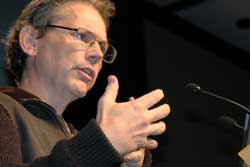Joy refreshes last two of his "six Webs"


Joy's six Webs -- the here, near, far, weird, B2B, and D2D (device to device) Webs -- are nothing new. Although he used different names for the last two, there are references to this framework dating back to 2000 if not before. Here's his description of the six Webs:
- The Near Web: the version of the Internet that's close to you. For example, when you're working on a computer or a notebook or other device with a keyboard that brings the Web near to you.
- The Here Web: Unlike the near Web, this is more about the anytime, anywhere, anyplace Web. This refers to all the devices that assure us that the Web is "with you here" wherever "here" may be.
- The Far Web: the version of the Internet that you visualize through a big screen and that you access through something like a cable box that's far away from you, using a remote control.
- The Weird Web. The weird Web is for applications like voice. Not just Voice over IP, but a voice driven Web. Joy says we need a scripting language for the voice driven Web so that you can tell it to fetch you certain information or connect you to someone, as opposed to using a keyboard or stylus to get the Web to do your bidding. Joy also said that the weird Web iswere an enormous amount of entrepreneurial activity is currently focused right now.
- The B2B (Business to Business): Previously referred to as the "e-commerce" Web, this is the firs to two intangible Webs (no physical device that you can touch). Joy said "The B2Bb2b Web does't have a consumer interface. It's business computers talking to each other to remove friction from business processes."
- D2D (Device to Device): Previously referred to as the "pervasive" Web, Joy said and example of this is a building having a lot of sensors and the sensors are self organizing, forming webs of information that allow you manage, monitor and control the building. That self-organization will probably rely on wireless mesh networks and that, as a result of it, machine intelligence will be embedded in all aspects of ordinary daily life. This Web doesn't exist yet, according to Joy.
After defining the six Webs, Joy talked a bit about how some companies are trying to bridge or transition categories. For example, he noted how Google and Yahoo are near Web companies that are looking to master mobility in hopes of becoming here Web companies but that the here Web is completely up for grabs since the cellular phone companies are missing the big picture (making a mistake) in the way they're running closed systems. Said Joy:
Cellular companies have largely protected and isolated their networks and are not seeing the larger picture. Technology will route around this bottlenecks using unlicensed spectrums where there's flat rate availablility of unlimited information. The innovation around this will bring the here Web platform forward.
[Editor's Note: David's photographs of the two-day MIT conference can been seen in these galleries: Day One and Day Two.]